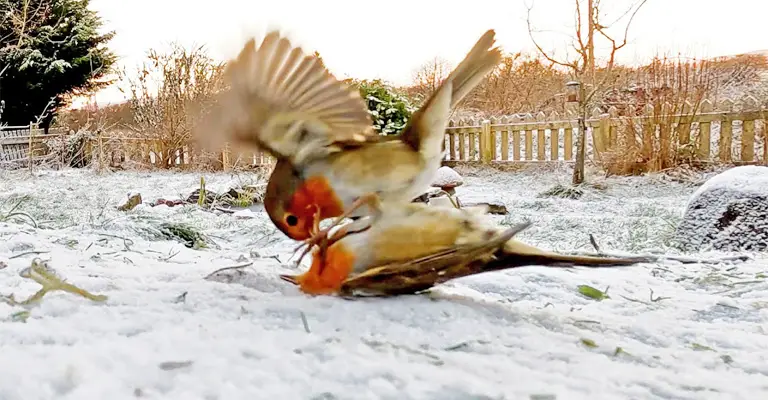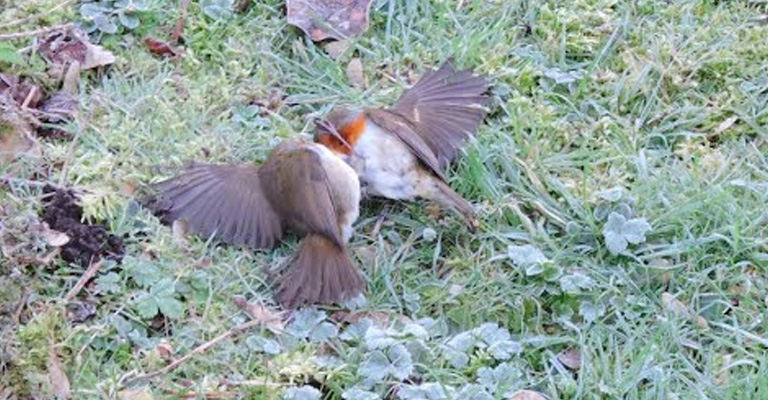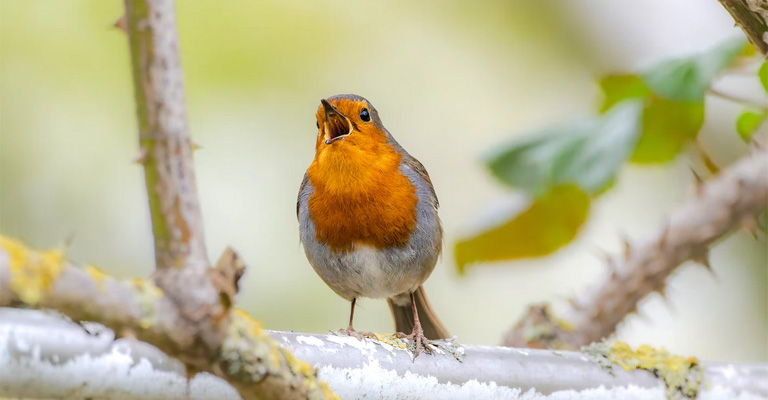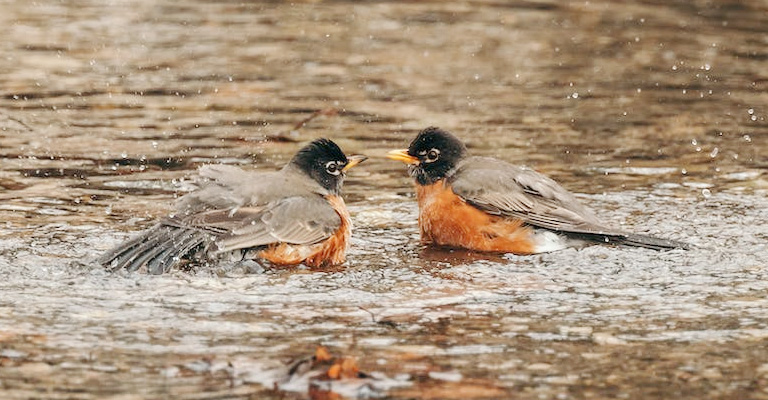Robins are small, territorial birds known for their beautiful songs and vibrant plumage. They are a familiar sight in many landscapes with their vibrant red breasts and melodious songs.
Another reason, they are known is their aggressive behavior and fight with each other. Beyond their captivating beauty and melodious tunes, they engage in intriguing territorial behaviors.
Fights between robins are not uncommon, serving crucial purposes such as establishing breeding territories and securing vital resources.
In this article, we will explore the reasons behind Robin’s fights and the behavioral displays associated with these conflicts. Let’s dive into this fact.

Causes Robins Fight Each Other
There are several reasons why Robins fight each other. The most common reasons are as followed.
The Transition Period
The transition period from winter flocks to the spring nesting season marks a crucial time for robins. As winter ends, flocks disperse, and individual robins seek out new territories.
This period is characterized by increased competition for resources such as food and nesting sites. Fights among robins occur as they establish their territories and secure the necessary resources for successful breeding.
Competition for Resources
During the breeding season, robins face limited resources, leading to intense competition. They aggressively fight to establish dominance and secure access to essential resources.
One critical resource is food availability, as robins require an ample supply of insects, worms, and berries to sustain themselves and their offspring.
Additionally, nesting sites are highly contested, with fights breaking out as robins vie for prime locations that provide safety and suitable conditions for raising their young. These resource competitions drive the territorial battles observed among robins.
Mating Opportunities

Fights among robins play a crucial role in attracting mates. Male robins fiercely defend their territories, using fights as a means to showcase their strength and dominance.
By successfully repelling rivals, they signal their suitability as mates to females. Male Robin’s behaviors during fights include vocalizations, aggressive displays, chasing, and physical confrontations.
These behaviors demonstrate their fitness and ability to provide resources and protection, increasing their chances of securing a mate and successfully reproducing
Territorial Defense
Territorial fights among robins serve as a means to protect their established territories. When robins return to their previous territories, they are determined to reclaim them and defend against intruders.
These fights involve various behaviors such as vocalizations, aggressive displays, chasing, pecking, and grappling.
The intensity of these confrontations communicates the level of threat and helps establish dominance hierarchies, ensuring that the rightful owners maintain control over their territories and the resources within them.
Ritualized Aggression and Communication

Fights among robins have often ritualized displays of aggression rather than attempts to cause harm. These confrontations involve various communicative behaviors, including vocalizations, displays, and physical confrontations.
They serve as a means for robins to establish dominance hierarchies and communicate their intentions to potential rivals.
By displaying their strength and determination through these rituals, robins can assert their positions without resorting to actual physical combat, reducing the risk of severe injuries or casualties.
Behavioral Patterns in Robin Fights
You should also learn the usual behavioral patterns of robins to understand the reason they are fighting for. Here are some essential facts that might amaze you.
Aggressive Displays

Robins engage in various aggressive displays during fights, such as spreading their wings, fluffing their feathers, and raising their crests. These displays are intended to intimidate rivals and establish dominance.
Vocalizations
Robin’s fights are often accompanied by vocalizations, including alarm calls, territorial songs, and aggressive calls. These vocalizations serve as communication signals and can escalate in intensity during confrontations.
Chasing and Pursuit
Robins engage in active chasing and pursuit of their rivals during fights. This involves one robin aggressively pursuing another in flight or on the ground, as they attempt to assert dominance or drive away intruders from their territory.
Physical Contact
Physical contact is common in robin fights, with individuals lunging, pecking, and grappling with their beaks. They may also use their feet to grapple and push against each other. However, fights are generally ritualized and rarely result in severe injuries.
Territory Defense Behaviors
During fights, robins exhibit territorial defense behaviors such as patrolling the boundaries of their territory, displaying aggressive postures near territorial borders, and actively repelling intruders.
Dominance Hierarchy Establishment
Robin’s fights contribute to the establishment of dominance hierarchies within their populations. Through repeated confrontations and displays of aggression, individuals establish their positions within the social order, which helps reduce the need for constant physical combat.
Ritualized Aggression
While fights can appear intense, they have often ritualized displays of aggression rather than serious attempts to cause harm.
Ritualized aggression helps minimize injuries and allows robins to communicate their intentions and level of dominance without escalating to more severe physical conflict.
Factors Influencing Fight Intensity

In this case, some essential factors truly influence those fighter robins. All those facts are listed below.
Availability of Resources in the Area
The availability of key resources such as food and nesting sites strongly influences the intensity of robin fights. When resources are abundant, fights may be less frequent and less intense as there is less competition for limited resources.
However, when resources are scarce or unevenly distributed, fights become more frequent and aggressive as robins vie for access to vital resources within their territories.
The scarcity of resources amplifies the importance of winning and defending a territory, leading to heightened fight intensity.
Population Density and Competition Among Robins
The population density of robins in a given area can significantly impact the intensity of fights. In areas with high robin densities, competition for territories and resources becomes more pronounced.
The increased number of individuals vying for limited space and resources escalates the intensity of fights as robins vigorously defend their territories against a higher number of intruders.
Higher population densities also lead to a higher frequency of fights as more robins vie for suitable breeding territories.
Impact of Environmental Conditions on Fight Frequency
Environmental conditions can also influence the frequency of Robin’s fights. Factors such as weather patterns, food availability, and habitat quality can affect the overall aggressiveness and territorial behavior of robins.
For example, during periods of adverse weather or reduced food availability, fights may intensify as robins become more desperate to secure essential resources.
Conversely, when environmental conditions are favorable and resources are plentiful, fights may be less frequent as the pressure to compete for resources decreases.
The combination of resource availability, population density, and environmental conditions collectively shapes the intensity and frequency of robin fights.
These factors reflect the adaptability and responsiveness of robins to their surrounding conditions, as they adjust their territorial behaviors in accordance with the availability of resources and competition levels.
Resolution and Maintenance of Territories
In this context, it is also essential to learn how Robin fights to reach a resolution and how territories are maintained in the long term.
Learning Territorial Boundaries and Hierarchy
After engaging in fights, robins gradually learn the territorial boundaries and establish a hierarchical structure within their population. Through repeated encounters and interactions, robins recognize the limits of each other’s territories and understand the dominance hierarchy within their community.
This learning process helps reduce the frequency of fights as robins become familiar with the established boundaries and respect the territorial rights of dominant individuals.
Decrease in Fight Frequency Over Time
Once territorial boundaries and hierarchy are established, the frequency of fights tends to decrease. This decrease occurs as robins recognize and accept their respective places within the dominance hierarchy.
Established robins typically exhibit a higher dominance status, while later arrivals or subordinate individuals yield and occupy territories of lower quality.
With the dominance hierarchy in place, fights become less necessary, and conflicts are resolved through non-physical displays and posturing instead.
Coexistence Outside of the Breeding Season and Flock Formation
Outside of the breeding season, robins display a greater degree of coexistence and even form loose flocks. While they maintain individual territories during the breeding season, robins tend to tolerate the presence of other robins in their vicinity when breeding activities are not at stake.
The formation of flocks provides benefits such as increased foraging efficiency and predator detection. However, it’s important to note that even within these flocks, individual territories are still respected, and fights may occur if boundaries are challenged.
The resolution and maintenance of territories in robins involve a combination of learning, recognition of hierarchy, and a decrease in fight frequency over time.
These mechanisms help establish a more stable social structure within the Robin population. Outside of the breeding season, robins exhibit a more flexible behavior, coexisting in loose flocks and recognizing the shared benefits of group living.
FAQs
While fights for territory are common among robins, not all individuals engage in aggressive behavior. Some robins may find unoccupied territories or establish territories through non-aggressive means, such as vocal displays and posturing, without physical combat.
Robin’s fights can involve aggressive behaviors and physical combat, but they are generally not excessively violent or harmful. Most fights consist of displays of dominance, vocalizations, and brief bouts of physical interaction.
The primary goal is to establish territory boundaries and assert dominance rather than causing serious harm.
The duration of Robin’s fights can vary. Some fights may be resolved within seconds or minutes, while others can persist for longer periods, especially if there is strong competition for limited resources or when territorial boundaries are being challenged.
While injuriRobin’ses can occur during robin fights, they are relatively rare and typically not severe. Robins have evolved to prioritize displays and posturing over prolonged physical combat.
Injuries, if any, are usually minor and heal quickly.
While robins primarily engage in fights with members of their own species, they may occasionally display aggression towards other bird species that encroach upon their territories.
These interactions are typically brief and serve as territorial defense rather than sustained combat.
Conclusion
As we have learned, robins fight each other for various reasons, including territory defense, mating competition, and resource competition.
Vocalizations and physical displays are common during fights, leading to the establishment of dominance hierarchies and the use of appeasement behaviors.
While fighting can confer fitness benefits, there are also potential risks and costs associated with these conflicts.
However, I can now anticipate that you’ve learned the fact well. Still, if you have any confusion left, please let us know. Thank you for your time.